A Far Sector Discussion with Scott and Mike
What I love about the beginning of Far Sector is that it starts en media res. Here’s a brand new Lantern on a brand new planet. It’s fresh, but you have to bring a certain schema to it. You kind of need to bring certain things to it.
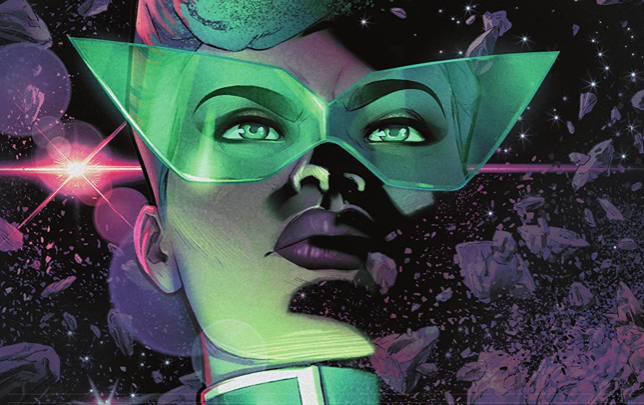
We're trying something different here. Scott and Mike had a discussion about Far Sector following the release of the collected edition and tried to capture it for the site. This is going to read differently than the normal site content you'd see. This isn't an analysis, per se. It's more of an appreciation, but it's really more of an informal conversation between friends. There are going to be ideas that would appear in a formal essay that we'll miss in this conversation, but there are going to be little noticings that won't come up when we're, for lack of a better term, trying.
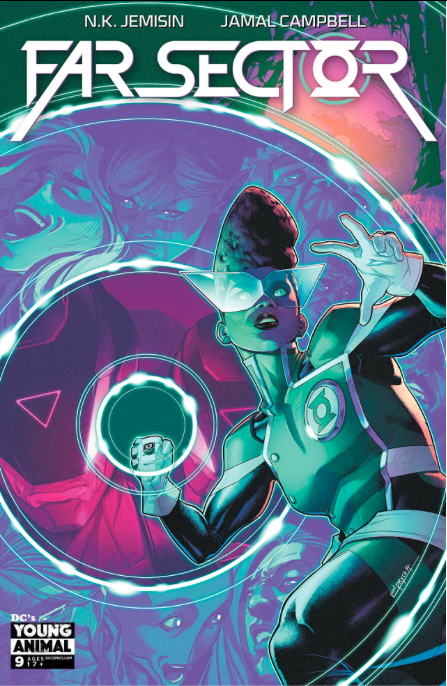
Mike: Scott, we read Far Sector two different ways, right? I read it as it came out in single issues and you picked it up in trade. Obviously, we’ll have different perspectives as a result, but I wanted to start before either of us even turned to page one. It’s safe to say that, for a few different reasons, Far Sector is different from most of the GL work that preceded it. Lantern books hold a special place for me. The Ron Marz/Daryl Banks Kyle Rayner run is arguably the first time I truly followed and collected a series, and Blackest Night 1 was the first single issue I bought when I got back into comics. Thus, I can’t help but look at it through that lens.
What’s your Lantern background? How do you step in?
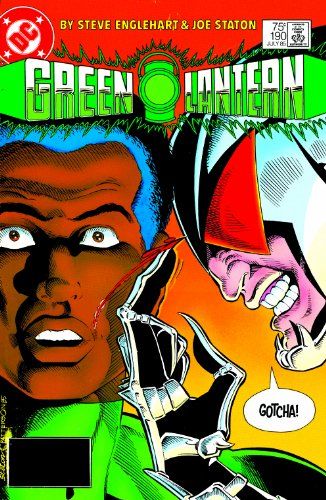
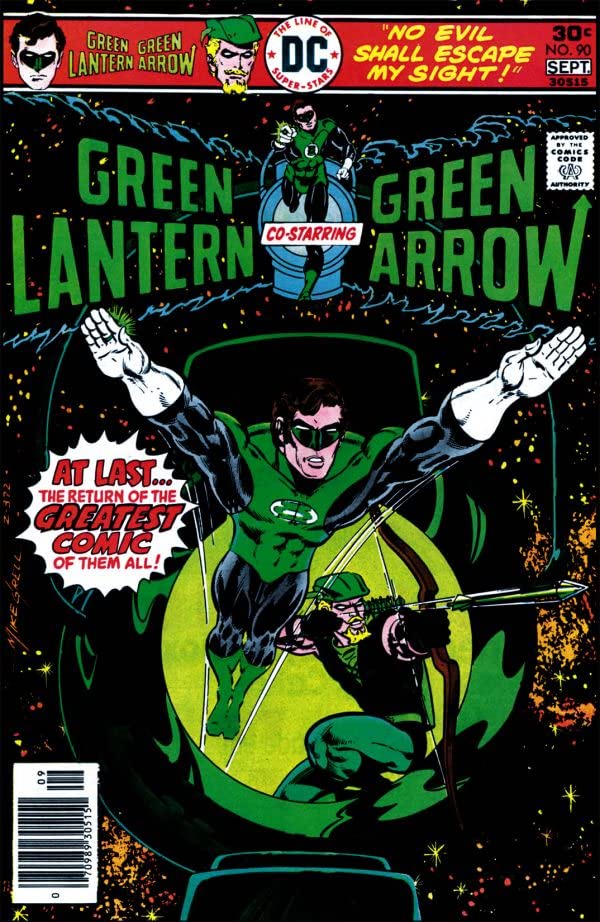
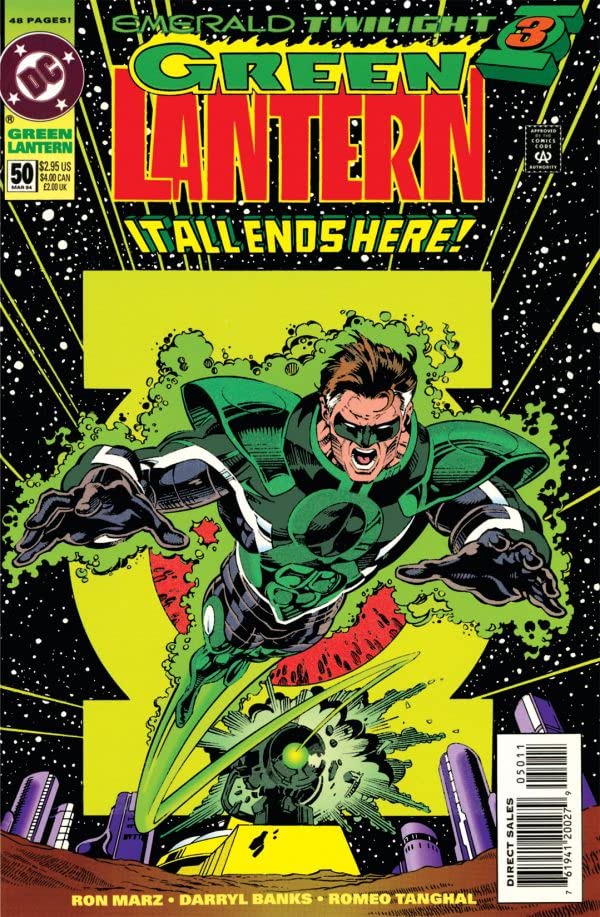
Scott: One of the first comics I remember having is Green Lantern #90 (thank you, DC Universe Infinite for reminding me that) from August 1976. It’s some weird issue co-starring Green Arrow and looks to be the first issue of the series after a 4-year hiatus following the Dennis O’Neil/Neal Adams run.
Hal Jordan, for as white bread and boring as he is, is probably one of my favorite characters but I love all the Lanterns, from Alan Scott to Simon Baz and Jessica Cruz. The whole concept of the Green Lantern, the corps, the ring, all of the ring slingers, human and alien, are just really fascinating to me. I don't know if I could say why but I just think that Green Lanterns are cool, which probably says a lot more about me than I wish it did.
I actually missed most of the Marz/Banks run. As it is a favorite concept, I can’t say I’ve followed the book with any great consistency over the years. I pretty much dropped out after the end of the Englehart/Staton post-Crisis run and didn’t really pick it up with any regularity until the Green Lantern: Rebirth era began and read it until the actual DC Rebirth cycle began.
Mike: That’s the funny thing about Green Lantern books, and it’s especially acute when you consider the trajectory of the books since the mid-90s. We had the fall of Hal, the death of the Corps, and the establishment of Kyle Rayner as the torchbearer. All of that, more than a decade’s worth of a new GL status quo, is what provides the impetus for the entirety of Johns’ run, at least the early stories. It's all about rebuilding everything back up, and he takes almost ten years to do it himself.
And I’d agree - as far as boring white dudes go, Hal is the best boring white guy out there. After Johns left the title towards the beginning of the New 52, GL was in a weird place. It was as if Johns had almost broken the title after rebuilding it. Like, where do we go from here? And the Rebirth titles tried to address that, especially with Green Lanterns, leaned into a whole different type of Lantern personality that Johns kind of ignored, but that helped define the early Rayner stories I read - an idea of vulnerability. Johns never really grasped that about Hal. Tomasi and Gibbons managed to inject more of that into The Corps. So, the two series that emerged after the Rebirth era GL series both ended - The Green Lantern and Far Sector - intrigued me because they seemed to be offering something different than any GL series I had ever read, but while maintaining this connection to the overall mythology.
What I love about the beginning of Far Sector is that it starts en media res. Here’s a brand new Lantern on a brand new planet. It’s fresh, but you have to bring a certain schema to it. You kind of need to bring certain things to it. What were your first impressions when you opened the trade?
Scott: I love the mystery of the first page, a bloodied hand lying on the ground in the rain. It’s such a classic opening for this kind of thrilling story. But then it’s the details that start to make the mystery even more compelling. The hand has seven fingers; there’s something else tattered and broken lying next to it. (You’ll come to realize what that is soon enough.)
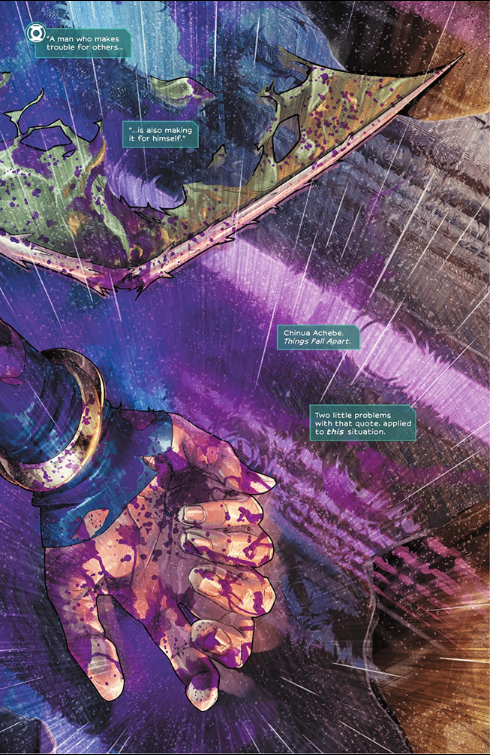
That’s just a captivating entry point into the story.
And then on the second page, we meet Sojourner Mullein, Jo for short, a Lantern officer dealing with the first murder on her new beat. It’s almost setting up a “Forget it, Jake. It’s Chinatown” mentality to Jo’s story that N.K. Jemisin and Jamal Campbell spend the rest of the book pushing back against.
And from there, Jo quickly became one of my favorite Lanterns, right up there with one Mr. Guy Gardner.
Mike: If there is any justice in this universe, we get the Jo Mullein/Guy Gardner buddy-cop Lantern book we deserve.
Scott: Do you want me to go into the attire similarities of Guy and Jo?
Mike: I literally want nothing else in the world.
Scott: One of the things I love about her is her uniform. It’s not the leotard that Hal and John wear. Her tunic is Guy’s tunic and that may just sway my feelings a bit. It certainly doesn’t hurt.
Now all she needs are the moon boots and the funky gloves.
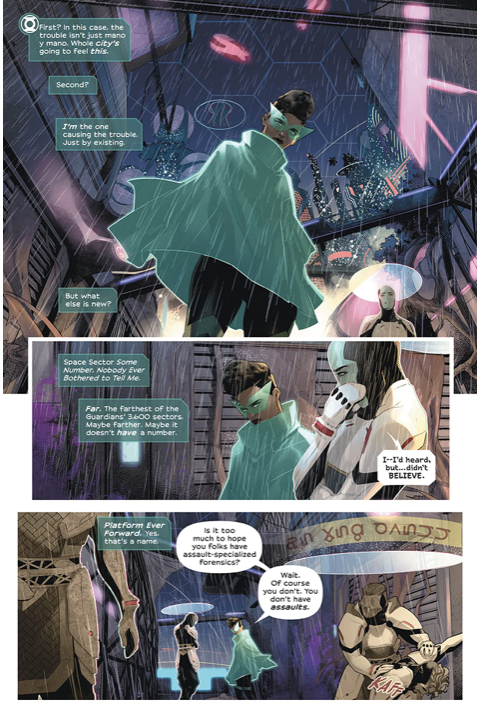
Mike: How about the art in this one? Was this your first experience with Jamal Campbell illustrating interiors?
Scott: He did one of the Bendis DC books, didn’t he? (Naomi according to Far Sector’s back cover.) I think I checked out one or two issues of that book but it didn’t really connect with me. And I (unfortunately) couldn’t tell you anything about the art so for all intents and purposes, this is the first thing of his that I’ve read and for the most part, his storytelling wowed me.
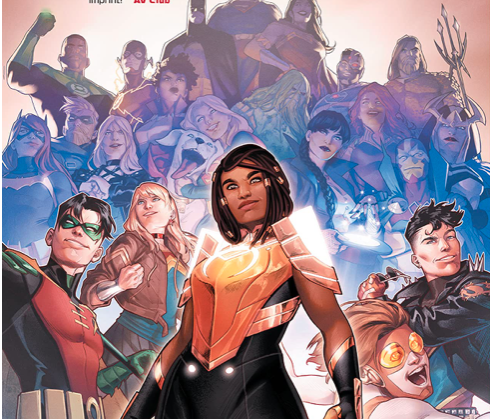
Mike: Beyond his ability to work as a storyteller (or maybe in conjunction with it), I was also impressed by his worldbuilding. I picked up Naomi in trade, and it was my introduction to Campbell. I’d recommend going back to Naomi because I think it’s ultimately a very charming, tender story, but it’s also enlightening to see the difference in how Campbell constructs that world compared to that of Far Sector. Perhaps that is a bit unfair since Naomi’s world is primarily Earth, but it’s the bright and brilliant color that I think helps sell the entire setup of Far Sector. The City Enduring is exactly what it needs to be - a futuristic world, shimmering and bombastic. There are so many great elements of cyberpunk that are cleaned up for the hyper-technological nature of this society. I love the setting as a whole. It’s lush yet sharp. It feels like the futuristic world I want it to be.
Scott: I was pulled in quite a bit by Campbell’s character work. To a degree, I think a lot of that worldbuilding got a little distracting for me. It helped really establish Jo’s stranger-in-a-strange-world setting and does give The City Enduring its own vibe but it’s the way that Campbell and Jemisin present Jo, Marsh, @ICanHazEarthStuff101, and everyone else that really made this story more than just another Green Lantern story.
Campbell gave these characters that extra dimension beyond Jemisin’s writing that made me fall in love with these characters, get mad and disappointed at them, and recognize that most of these people are just as flawed and unsure of themselves as I am. It’s the acting that Campbell draws out of his women and men that really builds their relationship.
Like, I’m trying to imagine this if it was drawn by someone else. Jemisin has a really good script here and a lot of this work is in her writing but think what this would be like with someone like Ivan Reis or Ed Benes drawing it. Not to say anything about their artwork other than it’s different from Campbell’s but the end product would have been much different and more superheroey than what we got.
Campbell is the perfect artist for this book because he manages to get us to see this world through Jo’s eyes and her perceptions. He’s a much more emotionally evocative artist than a Reis but he’s also able to (mostly) pull off the action, to create energy and power in his artwork.
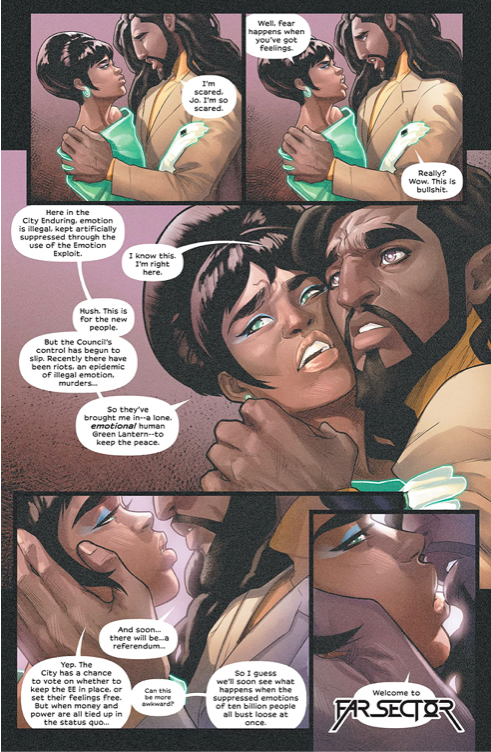
Mike: I’m so glad to see the way you’re analyzing Campbell because I was struggling to find the way to convey my thoughts other than “wow, dude creates some amazing pages.” For me, you’re hitting the nail on the head when you talk about the acting of the characters. Campbell gets gestures; he understands body language and facial expressions. It’s incredibly relevant and fluid. I think his entire style lends to the idea of movement. I felt in every issue like I was moving with the pages, different from simply an animated feel, cinematic in a manner distinct from widescreen action. The setting does a lot to help that feel, but it’s the characters that make it palpable. I think of the opening of issue six, where Campbell poses Jo and Marth in the style of a 70s romance melodrama (see image above.) Besides channeling Ahura through Jo’s look in this scene, which is indicative of the homages throughout the story, it’s also emblematic of Campbell’s ability to sell Jemisin’s dialogue.
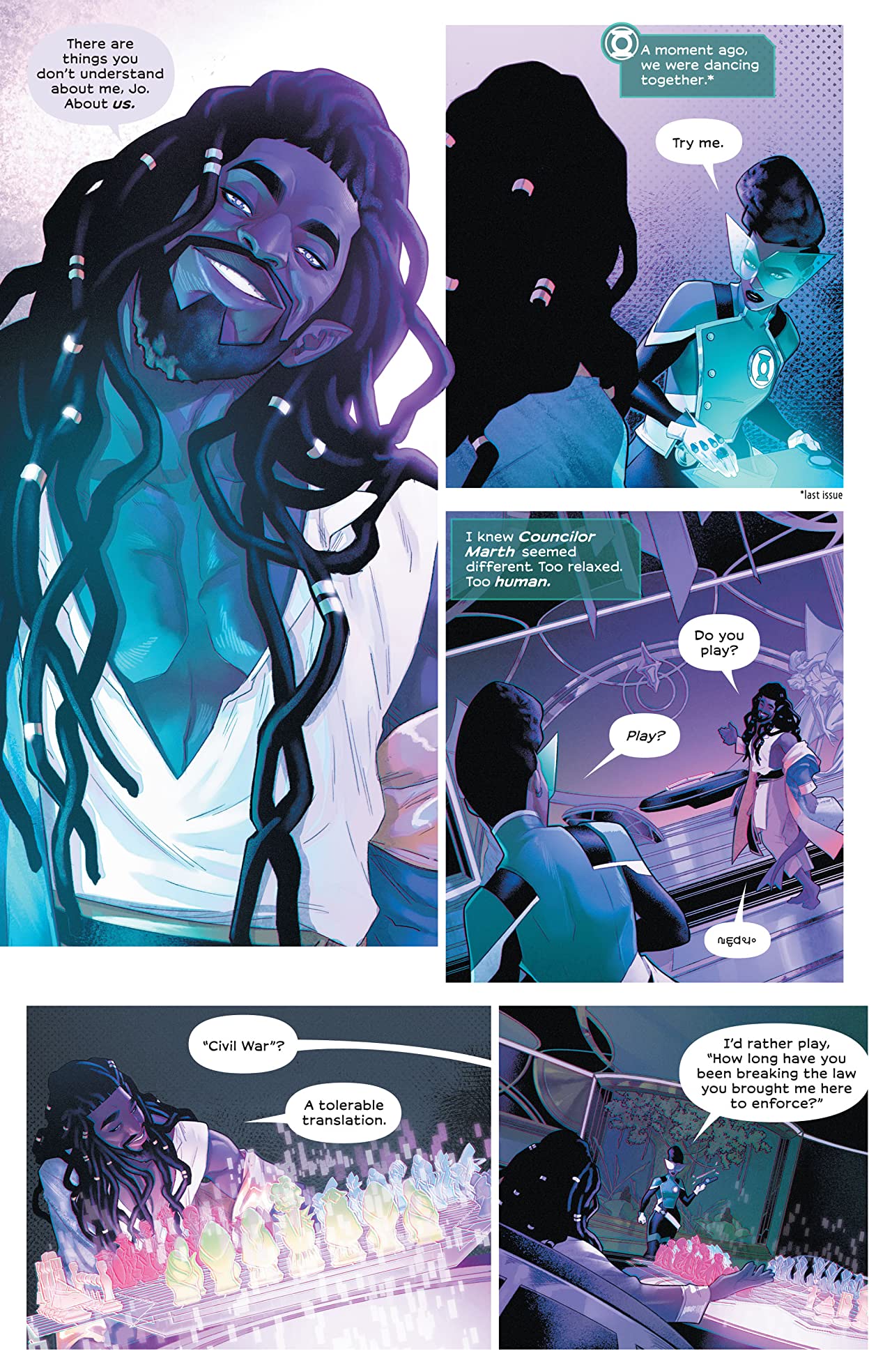
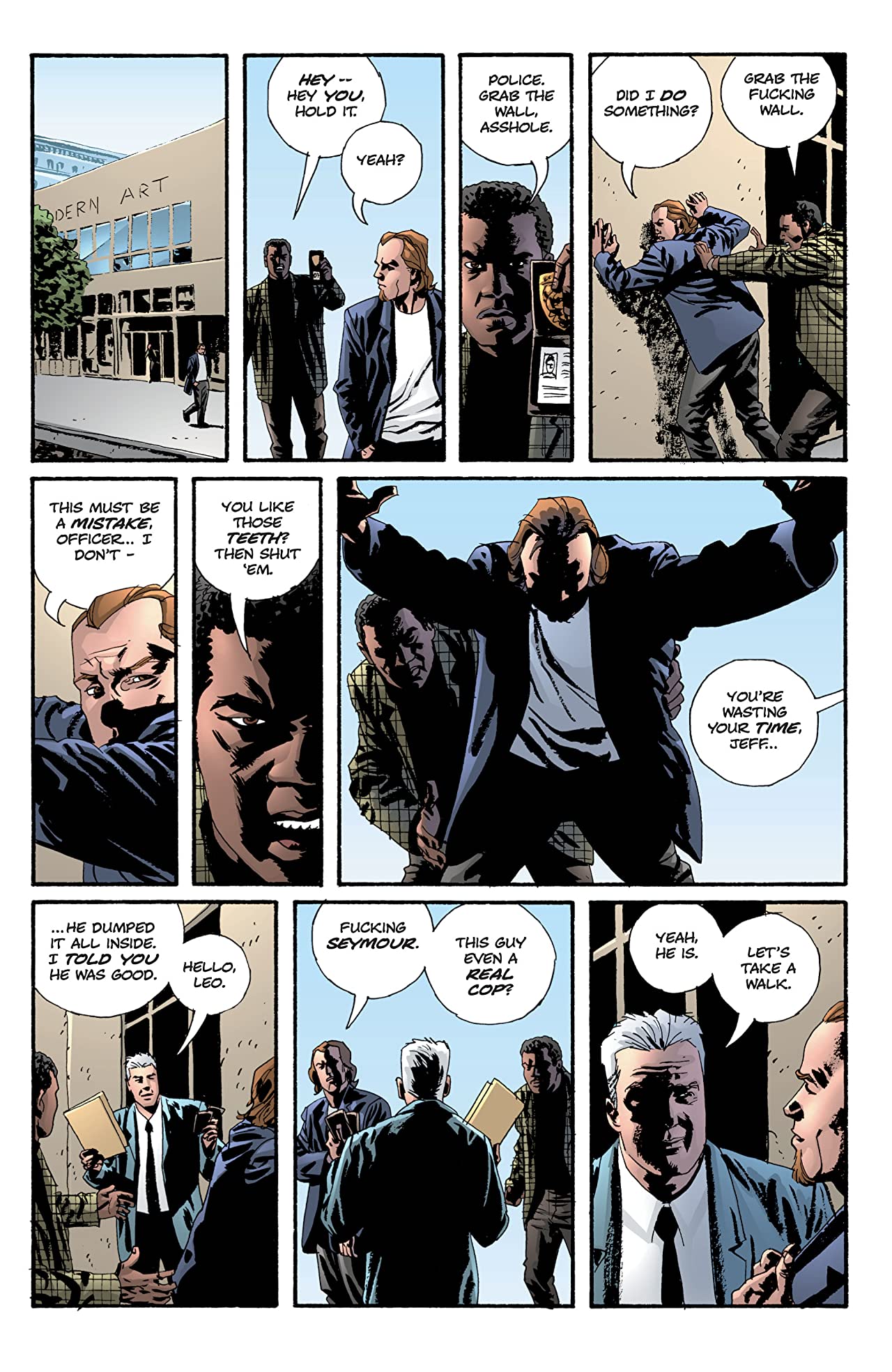
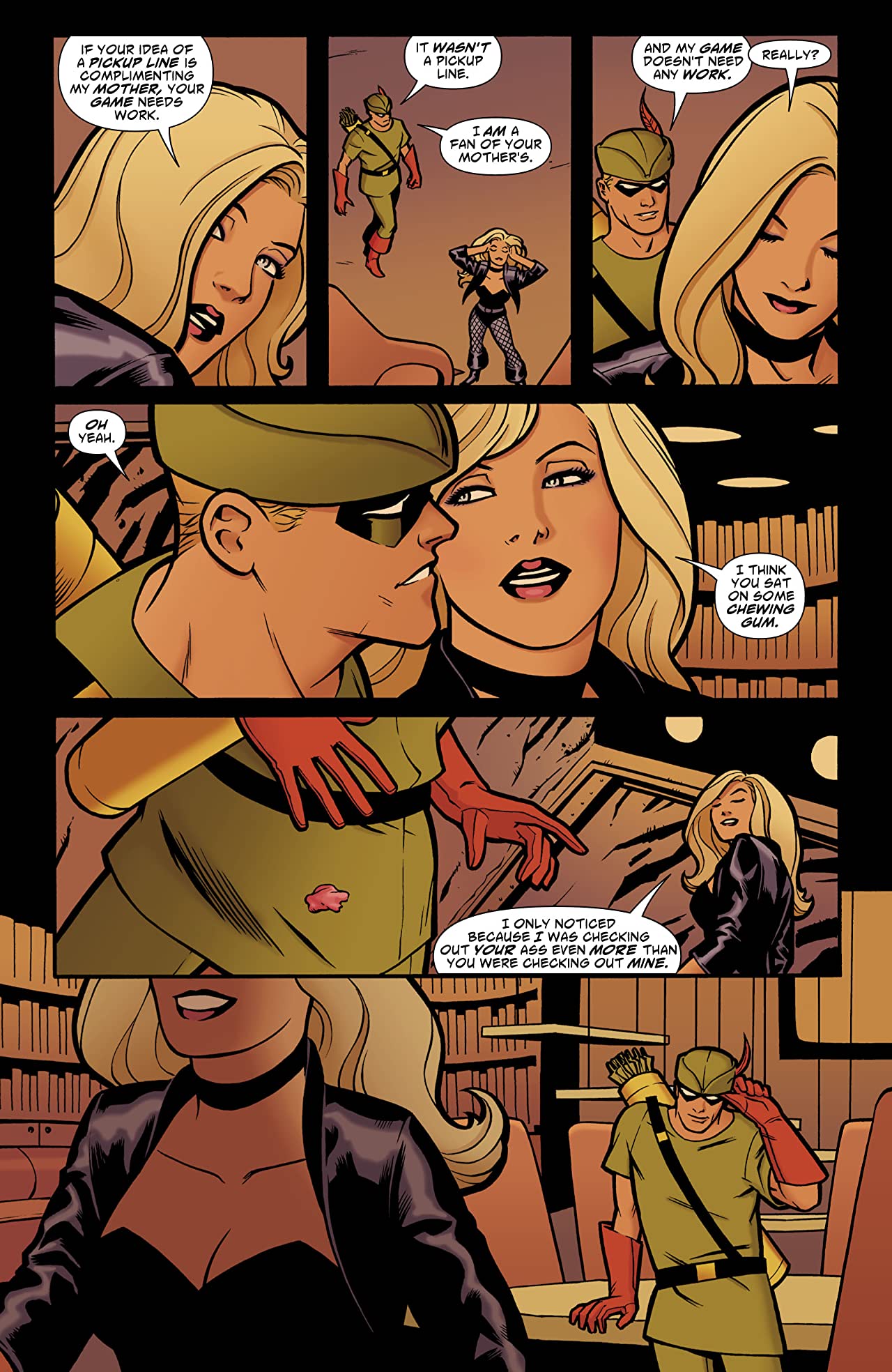
I feel like the acting component is something I want to come back to again after you started me thinking about it. We can sit here and decry house style for ages, but even some of the best mainstream and superhero artists who eschew a particular house style don’t capture the component of character acting that Campbell brings to this title. I can’t help but think of artists like Cliff Chiang or Sean Phillips who, like Campbell, build as much of the characterization and plotting through gestures and facial expression as through the actual writing/story/narration.
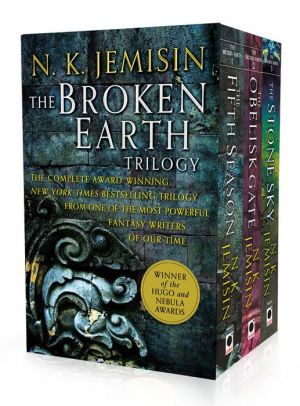
And really, I think that’s the half of this partnership that makes this book what it is. I’m not sure if you’ve read any N.K. Jemisin, but in addition to being a fantastic story, The Broken Earth trilogy is long and comprehensive. If I had some trepidation going into this series, it was about how Jemisin would transition to this medium. Plenty of science fiction and fantasy authors have tried their hand at comics with varying degrees of success. I wasn’t necessarily nervous that she would over-write the series, but I was nervous that there would be a lot of telling as opposed to showing. And I’m so happy I was wrong. I certainly think her scripts got tighter as the series progressed, and I can tell she was feeling the flow at the end to the point that I was hoping the run would get extended, but it really speaks to her skill as a collaborator that she, as a multiple award-winning author, can take a step back. I always feel restraint is the hallmark of any good comic writer, and it’s a fine line to toe. But she and Campbell really get it.
Scott: Campbell provides an energy to this that makes it more than just another Green Lantern story. I know that Jo is popping up in the Green Lantern title right now but while she’s a great character, it’s going to still be a bit before I can buy someone other than N.K. Jemisin writing her or Campbell drawing her. To me, this was a near-perfect partnership of words and pictures as both creators were really driven by and for the characters. This is a great story whether or not it was a Green Lantern book.
What I find so intriguing about this book is Jo. On Earth, she was a soldier and a cop but was she a good one? Her “origin” is that when she was a cop, she froze as her partner brutally beat someone in front of her. Yes, she reported her partner and tried to do the right thing afterward but I’m not too sure if Jemisin ever tries to exonerate her or absolve her of any potential sins here. It’s something that happened to her and the events of then are part of why she is the person she is now. She’s on this world that’s lightyears from the center of the galaxy and she’s essentially the galactic sheriff of the area but she doesn’t let anyone just be a perp or a nameless victim like she once kind of did back on Earth.
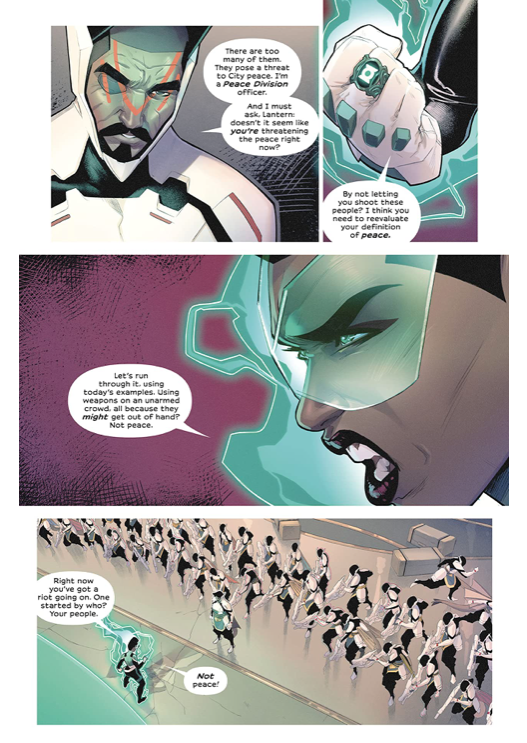
Jemisin slips these details into the story and they’re hard to read after the spring and summer of 2020 when police brutality was so much on display and the impetus to try to drive social change. Jemisin and Campbell acknowledge that corrupted part of our law enforcement and as Jo deals with these alien cultures, you can see prejudice and even pre-judgment as part of this new environment for her.
Mike: So what you’re telling me is that we need a follow-up? Sojourner Mullein: Year One?
Along the lines of exploring the "police" aspect inherent to all Green Lanterns, I was waiting to bring this up because I already said a lot about the previous GL series that have led up to Far Sector, but since you’ve brought up the Earth cop/space cop dynamic, I can’t help but want to ask what you think of Far Sector in light of Morrison/Sharp’s The Green Lantern (or vice-versa)?
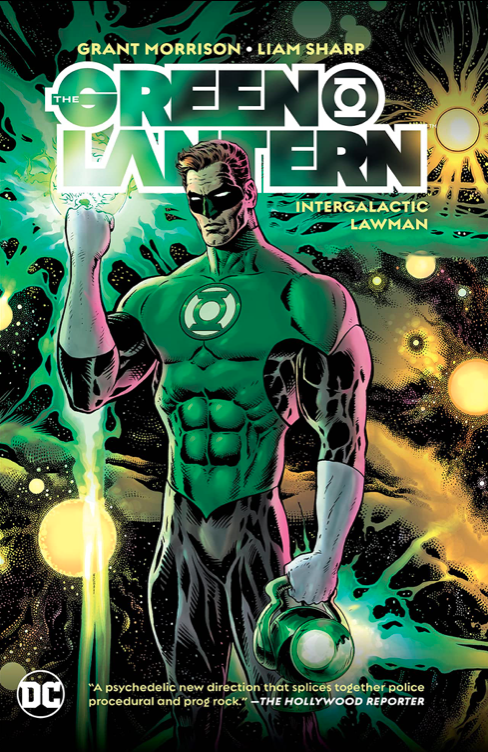
Scott: While I have all of Morrison/Sharp’s GL, it left me fairly cold and I lost interest in it. Sharp’s artwork is kind of pretty in a John Carter of Mars kind of approach to Hal Jordan but Morrison writing about a space cop just never sat right with me. It was just a weird combination of character and writer that never felt real, like Morrison said “sure, I’ll write a Hal Jordan comic” and then realized that they were never interested in Hal Jordan. You look at their Superman stories, Batman stories, and Wonder Woman stories and Morrison’s interest in the characters was the interest in their stories.
Read Scott's analysis of The Green Lantern Volume 1 here (note: this essay was published before Morrison began publicly using gender non-specific pronouns)
Jemisin and Campbell tell a far richer Green Lantern story than Morrison could. Morrison’s Hal Jordan is a cop who lives to serve the badge. Jo was a cop who wants to serve the people, which is what we want from our police officers. That’s why Jo is so fascinating-- so many Green Lantern stories are about the ring and all of the great things it can do. In Far Sector, the ring is secondary to the story. It’s a weapon or a tool but it doesn’t define who Jo is.
Mike: What snagged for me as a reader is that I think we had Morrison trying to shoehorn themselves into a character as opposed to using the character to tell a story they wanted to tell. I feel that, for Far Sector, what we got instead was finding a way to use a Green Lantern to tell a story. And I think it works much better that way unless you have an encyclopedic knowledge of a character.
Going a step further, I think Jemisin actually does a much better job exploring the nature of being a space cop. There are reflections on being an Earth cop, and the implications run both ways. There's more of an implied dialogue between these two aspects of her life. We didn't get that with Morrison.
Shifting gears, what did you think about Jeminsin’s ability to channel internet culture into the world of the City Enduring?
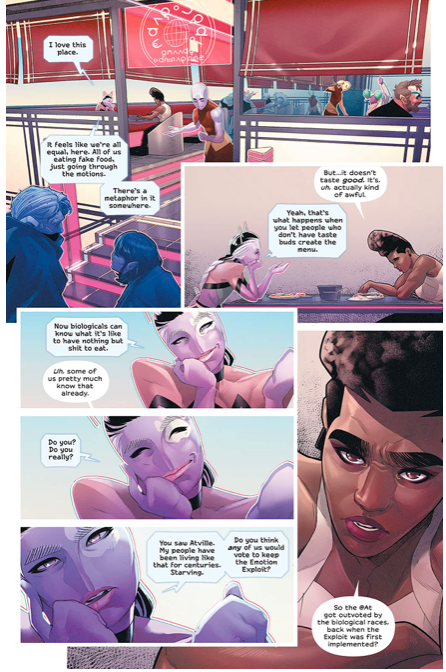
Scott: It’s probably the least interesting part of the story to me. For as much work as Jemisin and Campbell did developing this world and these cultures, the @At felt the least developed to me. It’s an interesting concept, a race of living search engines, but I think they get lost a bit in the story and end up becoming just the villains of the piece. The Nah and Keh-Topili feel more substantial to me. Maybe it’s the nature of the @At but they just never feel like they have a presence in this story other than as the mustache twirlers.
It's not to say that they're bad or anything but I just had such a stronger feeling for everyone else. But Jo's assistant CanHaz before the climax of the book tries to explain the @At to Joe and how they've been repressed by the powerful of The Enduring City and that makes them far more understandable to me than their exact nature did.
Do you have a different reading of them or how the story comments on internet culture?
Mike: Not a different reading, per se, but I’m intrigued by the concept. It’s part of the questions I have about the generalized construction of the story. I am curious about how much Jemisin already had a concept that she overlayed a Green Lantern story onto. I wonder if it would have worked differently as a novel if the world really received the necessary amount of attention. I think the idea of forgoing emotions is far more intriguing. What is it called? The Emotional Exploit? The commentary from that alone is enough for me to write an essay about. Jemisin is asking the most modern of questions, namely, how does consumption negate emotion. Then there is all the characterization and the depth of Jo as a character. Essentially, I would have been down for a 50 issue series, I think that is what I'm trying to say.
Scott: I think you’re reading the current Green Lantern and Jo just showed up there. Far Sector and the themes it explores are so far removed from the standard Green Lantern mythos so how is it seeing her interacting with John Stewart, Kilowog, and Teen Lantern?
Mike: Warning: spoilers ahead.
Ok - it’s a whole thing because I’m not sure what I think about the current Green Lantern run because I'm so put off by the art. It is far more formulaic than anything we saw in Far Sector. It starts with another grave threat to the Guardians and Oa at large. Long story short, rings stop working, thousands of Lanterns die at random, and there are only two whose rings still work - those of Jo and Keli, the Teen Lantern (though her gauntlet was never tied to the battery anyhow).
Nonetheless, there are two stories running parallel. One is John’s. He led a mission into uncharted space when the lights went out, and he’s kind of going through an Odyssey to return home. Jo has assumed the role of de facto corps leader and is tasked with finding the stranded Lanterns. She hasn’t had much interaction with established Corps members outside of Simon Baz, who I never truly warmed up to because I always thought he was written as a jerk. Guy and Kyle are still MIA. Jessica Cruz is a Sinestro Corps member. Kilowog is just beginning to come back into the story. And Hal is on Earth. His ring still works, too, of course. We don't know why yet. Jo got to meet Sinestro, and that's something I'd like to see again.
But essentially, she hasn't had any major face time with any of the Lanterns you'd like. I’d love to see her interact more with the Corps writ large. But, I also think I'd rather just see another Far Sector story. That or the Guy Gardner team-up. Maybe both.
Scott: It’s a bit like you said-- Far Sector’s story almost works whether or not Jo is a Green Lantern. That’s what I really like about that book-- the power and the costume are secondary to the characters.
Mike: That's the danger, here. I think you’re on the money. The problem with Morrison’s The Green Lantern was that they seemed to be writing a story about Hal, not a Morrison story for Hal. Jemisin writes a Jo Mullein story (whoever Jo started as), and now Jo finds herself in the middle of a typical GL story as others have continued her story. I’d love to see how she fits, but I almost don’t want her to fit because I prefer her as her own thing, not just another GL. In recent years, the only GL that has stuck out from the pack is Jessica Cruz. I’m intrigued by where the current series is going because it’s tapping into some of the threads Jemisin placed, namely the different origin of Jo’s ring and the different nature of her mission, so I'll hang in there for a little while, but it isn't ideal.
Scott: When Far Sector is about her being a Green Lantern, it’s about her being something different and unknown by most of the Corps. Jo exists outside of continuity that way until she’s brought into it and just seemingly becomes just another Green Lantern.
Mike: And there is precedent for that within the mythology of the GLC. At a certain point in their run, that is what Tomasi and Gleason were exploring. There is a richness to these characters that has been eschewed for a while now. Most creators tend to focus on the idea that they are Green Lanterns, as opposed to the idea of why or how they are Green Lanterns.
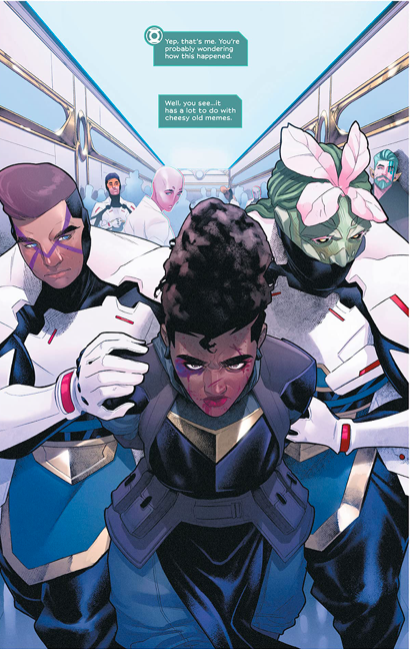
Scott: I’m more interested in future stories about Jo being an officer assigned to a sector far removed from anything else than in her being another Green Lantern fighting Sinestro or Hector Hammond.
Jemisin and Campbell need to do a Far Sector: Season 2 series.
Mike: I can live in a world where she shows up in team books, but I'd prefer to see her in more solo adventures. A Season 2 would be fantastic. A new mission, some more information about the nature of her ring, and the Guardian who gave it to her - I'd love to keep going with her as a character. I wonder how much will carry over from the continuity-adjacent Young Animal curated line to the DC Universe proper.
Scott: Jo’s too good a character not to be seen again. I don’t know what Jemisin and Campbell’s plans are, whether or not they want to tell another story. But I hope whoever picks up on her, who really steps in next to advance her story, understands what kind of person Jo is. I guess she’s a Green Lantern but she’s also someone who has learned to care about the people she works with but more importantly the people she protects. It’s that empathy for people that really sets her apart and makes her the type of person I want to read more of. She’s not perfect; she’ll be the first to admit it. But she’s trying to be better.
Jemisin and Campbell have created a character who lives and breathes, who has feelings, and who makes mistakes. She feels so much more complete after just 12 issues than so many other characters feel after decades of stories trying to define them.
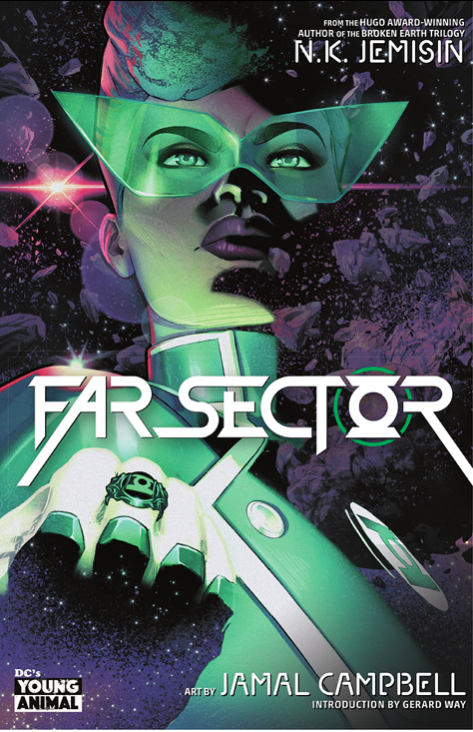


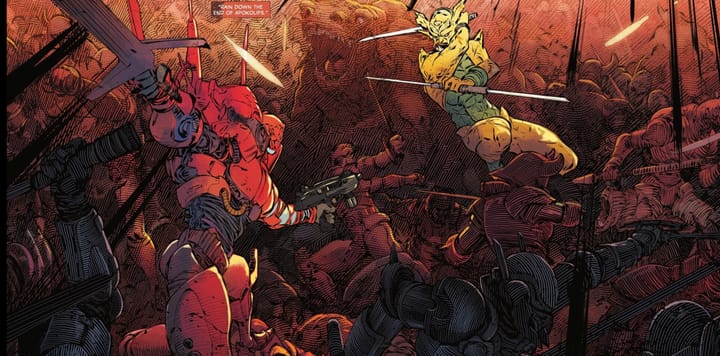
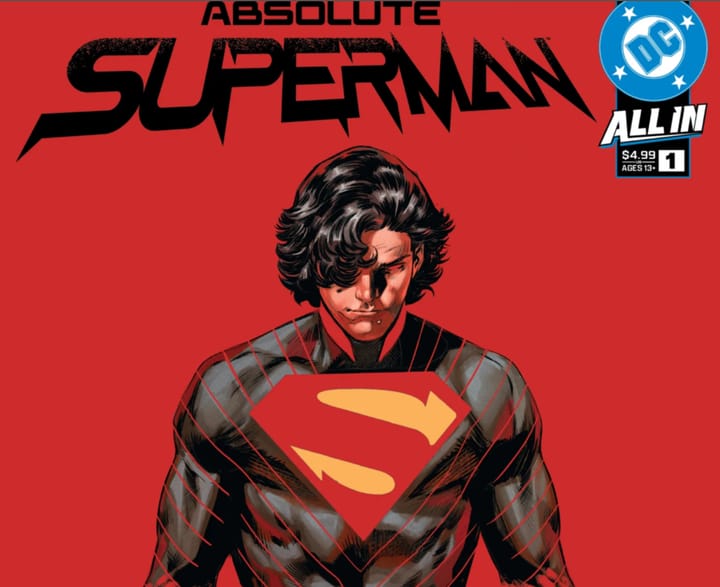
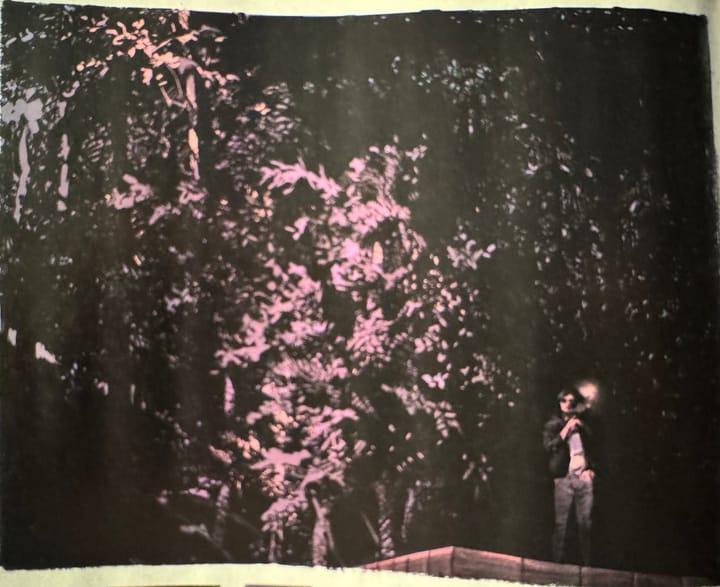
Comments ()